
Wine Culture and Information since 2002 - Volume 22
 Wine Culture and Information since 2002 - Volume 22 |
|
Comparing Dolcetto d'AlbaIn the many interpretations Piedmont gives of Dolcetto, the wines produced at Alba with this grape certainly are the most common and the most famous ones |
|
Dolcetto is the most common grape in Langhe, the great wine land of Piedmont, mother of the great and celebrated Barolo and Barbaresco, both produced with the noble Nebbiolo. Dolcetto - probably overshadowed by these two great wines of Langhe, as well as by other wines made from Nebbiolo and Barbera grapes - is not very common among consumers, maybe also because of its name, recalling something basically sweet instead of a dry wine. In fact, in Italian language, dolcetto literally means something having a basically sweet taste. On this regard, we should remember Dolcetto is a grape and not a style of wine, and it takes its name from the evident sweet taste of its berries. Once was particularly advised the consumption of Dolcetto grape to anyone suffering from stomach disorders, just because of its high sweetness and low acidity. Dolcetto is however capable of making excellent wines, this also thanks to the seriousness and commitment of some producers who made of Dolcetto a great wine, rich in pleasing surprises for the taster. The origin of Dolcetto is not completely clear. Some believe this grape is native of Langhe, others believe its origin is in Liguria, where it is known as Ormeasco. In both cases, it is believed Dolcetto arrived, in one or the other area, after commercial trades in medieval times. The first certain evidences of Dolcetto are dated back to 1700s, and only in 1800s its cultivation will be spread all over Langhe, becoming one of the most typical and common wines of this lands. Dolcetto is used in Piedmont for the production of eleven Denominazione d'Origine Controllata monovarietal wines (Denomination of Controlled Origin, DOC) as well as two Denominazione d'Origine Controllata e Garantita wines (Denomination of Controlled and Guaranteed Origin, DOCG). Of these, Dolcetto d'Alba certainly is the most famous and common one outside Piedmont. Dolcetto d'Alba is produced in the lands located to the right bank of Tanaro river, in that part of territory where the renowned hazelnuts are being cultivated.
|
|
Dolcetto d'Alba, and the same can be said for the other Dolcettos produced in Piedmont, is a wine expressing with freshness of aromas and flavors of flowers and fruits its pleasing character. This does not however mean Dolcetto is a lesser wine or a wine having no value, as there are many cases in which this grape is capable of making wines of interesting structure and complexity, even without using wood. The quality of fruits and flowers of Dolcetto have always suggested producers to vinify this grape in inert containers and the cases in which it is used a cask or a barrique are rare. Dolcetto is a variety riping in advance than the other grapes of the area and harvesting is usually done around the half of September. The cultivation of Dolcetto is usually done in marnous and limestone soils, in hilly lands at altitudes from 250 to 600 meters. According to the production disciplinary, Dolcetto d'Alba is exclusively obtained with this variety only, it must have a minimum of 11.5% of alcohol by volume and there are no minimum aging times prior to commercialization. In case alcohol is higher than 12.5% and aged for at least one year, Dolcetto d'Alba can mention “superiore” in the label (superior).
Our comparative tasting will study three Dolcetto d'Alba wines produced with different wine making techniques. One of them is in fact aged in barrique, whereas the other two followed the “typical” vinification method with an exclusive aging in inert containers. The first wine is Seghesio's Dolcetto d'Alba Vigneto della Chiesa, aged for 9 months in steel tanks. The second wine of the comparative tasting is Mossio's Dolcetto d'Alba Bricco Caramelli, also in this case aged in steel tanks. The third wine is Enzo Boglietti's Dolcetto d'Alba Tiglineri, aged for 8 months in barrique. Whereas in the first two wines the quality of Dolcetto will be expressed without “interferences”, it will be interesting to compare these two wines with the third one in order to understand the influence of wood in Dolcetto grape. The three wines will be selected according to the most recent vintages commercialized by respective producers. The first two Dolcetto d'Alba wines will be served at the temperature of 17° C (62° F), whereas for the third wine we will choose a temperature of 18° C (65° F). The wines will be served in three ISO tasting glasses.
|
||||||||
|
Dolcetto is a grape with a pretty high content in coloring substances, a quality which always distinguishes its wines. According to Piedmontese tradition, wines produced with Dolcetto grape are consumed young and they are not generally allowed to age for a long time. Despite this traditional rule, some producers successfully age their Dolcetto wines for some years, proving an unsuspected longevity. Transparency of Dolcetto is generally low, in some cases it can also be seen the complete impenetrability of light. Dolcetto d'Alba shows an intense and deep ruby red color, sometimes showing an evident purple red color. Nuances in color of this wine show bright and evident purple red hue, a very frequent quality because of the custom of consuming Dolcetto after few months from production. In some exemplars of Dolcetto d'Alba - and the same can be found in other Dolcetto wines - it can be seen, when the wine is poured in a glass, the formation of a moderate foam of purple color. We will begin the examination of appearance from Seghesio's Dolcetto d'Alba Vigneto della Chiesa. By holding the glass tilted over a white surface - a simple sheet of paper is enough - we will observe the color at the base of the glass. It will be observed an intense ruby red color with a pretty low transparency, whereas nuances, observed towards the opening of the glass, in the point where the wine has the lesser thickness, will be characterized by an evident purple red. Let's now pass to the analysis of the second wine of our comparative tasting: Mossio's Dolcetto d'Alba Bricco Caramelli. The color of this wine is pretty similar to the previous one and also in this case can be observed an intense ruby red color and a pretty low transparency, whereas nuances will show the typical purple red color. Let's now pass to the examination of the third wine: Enzo Boglietti's Dolcetto d'Alba Tiglineri. As opposed to the other previous wines, this Dolcetto shows a more intense and deep ruby red color with a lower transparency, however showing in nuances the typical purple red color.
|
|
One of the most interesting characteristics of Dolcetto d'Alba is probably represented by its freshness in aromas, a quality which is more and more forgotten in some wines because of the use - sometime exaggerated - of casks and barriques. Wines produced with Dolcetto generally have an immediate and straight character, where aromas of fruits and flowers make the dominant qualities of the olfactory profile. In Dolcetto d'Alba can in fact be perceived aromas of cherry and blackberry, as well as a fruit which could be considered unusual and which expresses its bitter character: almond. Among the most frequent flower aromas in Dolcetto d'Alba is found violet and, sometimes, rose and cyclamen. Another fruit which can be perceived in Dolcetto, in particular in young wines, is peach, a sensation generally found in white wines. Other typical aromas in Dolcetto include plum, strawberry, raspberry and blueberry. The aging in wood, which in Dolcetto is quite unusual, enriches the wines with tertiary and spicy notes, which should however keep - for the sake of balance - unaltered and well perceptible the aromas of fruits and flowers, a fundamental quality of Dolcetto. The first wine of which we will examine aromas is Seghesio's Dolcetto d'Alba Vigneto della Chiesa. By holding the glass in vertical position and without swirling, we will proceed with the evaluation of opening aromas, that is the identifying qualities of the wine and which are expressed with pretty small quantities of oxygen. From the glass will be appreciated intense, clean and pleasing aromas of cherry, plum and blueberry, qualities which can be usually found in Dolcetto d'Alba. Let's now proceed with the swirling of the glass, in order to allow a proper oxygenation of the wine and therefore the development of other olfactory qualities which will complete the profile of the first wine. The second smell will allow the perception of violet and cyclamen - typical flowery aromas of Dolcetto - to which will be added the sensations of blackberry and raspberry, as well as a hint of carob. It will also be perceived an aroma with a basically bitter character in which will be recognized almond, another typical quality of Dolcetto. Let's now pass to the evaluation of the aromas of the second wine of our comparative tasting: Mossio's Dolcetto d'Alba Bricco Caramelli. The opening of this second Dolcetto - evaluated without swirling the glass - allows the perception of cherry, blackberry and plum. We will now proceed with the swirling of the glass, therefore favoring the development of other aromas and which will complete the olfactory profile with violet, raspberry, blueberry and strawberry as well as the flowery sensation of cyclamen. In this Dolcetto too can be found the aroma of almond as well as a pleasing hint of anise. Let's now proceed with the examination of the third wine - Enzo Boglietti's Dolcetto d'Alba Tiglineri - the only wine of the three to be aged in barrique. The opening of this Dolcetto is characterized by cherry, plum and blackberry, whereas the swirling of the glass will express the aromas of blueberry, raspberry, violet, cyclamen and peach, as well as the pleasing hint of almond. In this wine will also be perceived aromas of vanilla and the balsamic character of eucalyptus, qualities contributed by the aging in barrique.
|
||||
|
Despite of its name, wines produced with Dolcetto are absolutely dry, with a moderate astringency and acidity, leaving in the mouth - after swallowing - a pleasing and slightly bitter flavor. Dolcetto is known for its freshness and simplicity, however there are wines produced with this grape to have interesting characters of complexity. This simplicity is generally determined by the moderate acidity and a modest astringency of tannins, qualities making Dolcetto meet the favor of consumers, also for the pleasing fruit flavor perceived in the mouth. Despite the production disciplinary provides for a minimum alcohol by volume of 11.5%, there are Dolcetto wines with higher quantities of alcohol, in some cases reaching 13.5%. The aging in wood, as it can be easily thought, increases astringency and body of Dolcetto, therefore in these wines balance is obtained with a proper quantity of alcohol. Despite its acidity is modest, this characteristic is however well perceptible, in particular in wines with a modest content in alcohol, making Dolcetto even more pleasing. Let's examine the first wine of our comparative tasting: Seghesio's Dolcetto d'Alba Vigneto della Chiesa. The attack of this wine fully confirms the characteristics of Dolcetto, with a moderate astringency and a pleasing sensation, also in this case moderate, of freshness, as well as intense flavors of fruits, in this case expressed by cherry, blueberry and plum. Let's now pass to Mossio's Dolcetto d'Alba Bricco Caramelli. In this wine astringency is evidently higher than the previous Dolcetto, showing a fuller structure, although having a pleasing freshness and the typical fruit character, that in this wine is expressed by cherry, plum and blackberry. It should be noticed how alcohol contributes to the balance both of astringency and structure. Let's now pass to the third wine of the comparative tasting - Enzo Boglietti's Dolcetto d'Alba Tiglineri - in which can be perceived a rounder and fuller attack than the previous wines, qualities deriving from the aging in barrique. Also in this case the role of alcohol is fundamental for the balance of wine. Finally, it should be noticed the perception of the flavors of cherry, blackberry and blueberry, as well as the influence of wood in flavors.
|
|
The three wines of our comparative tasting fully confirm the straight character of Dolcetto d'Alba - and, of course, this is not a fault - as well as emphasizing the fact with this grape can be made quality wines and with a high sensorial interest. The finish of Seghesio's Dolcetto d'Alba Vigneto della Chiesa is persistent, leaving in the mouth the typical fruit flavors of the grape, such as cherry, plum and blueberry. Also the finish of the second wine - Mossio's Dolcetto d'Alba Bricco Caramelli - is characterized by a long persistence, leaving in the mouth intense and clean flavors of cherry, plum and blackberry. The finish of the third wine, Enzo Boglietti's Dolcetto d'Alba Tiglineri, is not anything less than the previous wines, with a long persistence, intense and clean flavors of cherry, plum, blueberry and raspberry, as well as a fuller body and roundness than the two previous wines. Finally, it should be noticed the basically bitter taste which can be perceived in the mouth after having swallowed the wines and in which can be recognized almond, like we already said, a typical characteristic of Dolcetto.
|
Wines of the Month |
|
|
|
Score legend Prices are to be considered as indicative. Prices may vary according to the country or the shop where wines are bought |
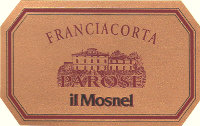
|
|
Franciacorta Rosé Pas Dosé Parosé 2004 |
|
| Il Mosnel (Lombardy, Italy) | |
| Grapes: Pinot Noir (70%), Chardonnay (30%) | |
| Price: € 28.00 | Score: |
| Franciacorta Rosé Pas Dosé Parosé shows a brilliant onion skin pink and nuances of pale pink, very transparent, fine and persistent perlage. The nose reveals intense, clean, pleasing, refined and elegant aromas that start with hints of cherry, raspberry and tangerine followed by aromas of bread crust, yeast, strawberry, hawthorn, pink grapefruit, plum, apple and hints of vanilla. The mouth has good correspondence to the nose, an effervescent and crisp attack, however balanced by alcohol, good body, intense flavors, pleasing roundness. The finish is persistent with flavors of cherry, raspberry and strawberry. Franciacorta Rosé Pas Dosé Parosé referments in bottle on its lees for at least 30 months. The base wine used for the production of this Franciacorta ages in barrique. | |
| Food Match: Roasted white meat, Roasted fish, Fish soups, Broiled fish | |
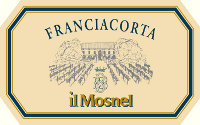
|
|
Franciacorta Brut Emanuela Barboglio 2004 |
|
| Il Mosnel (Lombardy, Italy) | |
| Grapes: Chardonnay | |
| Price: € 28.00 | Score: |
| Franciacorta Brut Emanuela Barboglio shows a brilliant straw yellow color and nuances of straw yellow, very transparent, fine and persistent perlage. The nose reveals intense, clean, pleasing, refined and elegant aromas which start with hints of banana, bread crust and acacia followed by aromas of yeast, pineapple, hawthorn, pear, butter, plum, hazelnut, praline and hints of vanilla. The mouth has good correspondence to the nose, an effervescent and crisp attack, however balanced by alcohol, good body, intense flavors, pleasing roundness. The finish is persistent with flavors of banana, plum and praline. Franciacorta Brut Emanuela Barboglio referments in bottle on its lees for at least 36 months. The base wine of this Franciacorta ages in barrique for 5 months. | |
| Food Match: Roasted fish, Roasted white meat, Stuffed pasta, Mushroom soups | |
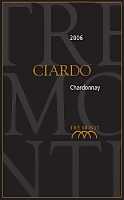
|
|
Colli di Imola Chardonnay Ciardo 2008 |
|
| Tre Monti (Emilia Romagna, Italy) | |
| Grapes: Chardonnay | |
| Price: € 11.00 | Score: |
| Colli di Imola Chardonnay Ciardo shows a brilliant straw yellow color and nuances of straw yellow, very transparent. The nose reveals intense, clean, pleasing and refined aromas which start with hints of banana, apple and acacia followed by aromas of pineapple, white rose, pear, grapefruit, plum and vanilla. The mouth has good correspondence to the nose, a crisp attack and however balanced by alcohol, good body, intense flavors, pleasing roundness. The finish is persistent with flavors of apple, banana and plum. A small part of Colli di Imola Chardonnay Ciardo ages in barrique. | |
| Food Match: Stuffed pasta, Roasted fish, Roasted white meat, Stewed fish | |
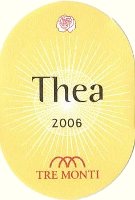
|
|
Sangiovese di Romagna Superiore Riserva Thea 2006 |
|
| Tre Monti (Emilia Romagna, Italy) | |
| Grapes: Sangiovese | |
| Price: € 17.00 | Score: |
| Sangiovese di Romagna Superiore Riserva Thea shows a brilliant ruby red color and nuances of ruby red, moderate transparency. The nose reveals intense, clean, pleasing, refined and elegant aromas which start with hints of black cherry, plum and violet followed by aromas of raspberry, rose, blueberry, blackberry, vanilla, chocolate, tobacco, cinnamon, pink pepper and menthol. The mouth has excellent correspondence to the nose, a tannic attack and however balanced by alcohol, full body, intense flavors, pleasing roundness. The finish is very persistent with long flavors of black cherry, plum and blackberry. A well made wine. Sangiovese di Romagna Superiore Riserva Thea ages for 12 months in barrique. | |
| Food Match: Game, Roasted meat, Stewed and braised meat with mushrooms, Hard cheese | |
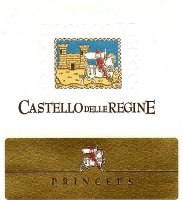
|
|
Princeps 2003 |
|
| Castello delle Regine (Umbria, Italy) | |
| Grapes: Cabernet Sauvignon (60%), Sangiovese (20%), Merlot (20%) | |
| Price: € 19.00 | Score: |
| Princeps shows an intense ruby red color and nuances of garnet red, little transparency. The nose denotes intense, clean, pleasing and refined aromas which start with hints of plum, black cherry and violet followed by aromas of black currant, vanilla, blueberry, tobacco, raspberry, cocoa, mace and menthol. The mouth has good correspondence to the nose, a tannic attack and however balanced by alcohol, good body, intense flavors. The finish is persistent with flavors of black cherry, plum and black currant. Princeps ages for 12 months in barrique followed by more than 24 months of aging in bottle. | |
| Food Match: Roasted meat, Braised and stewed meat, Hard cheese | |
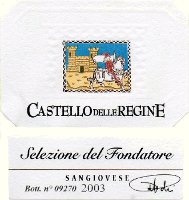
|
|
Selezione del Fondatore 2003 |
|
| Castello delle Regine (Umbria, Italy) | |
| Grapes: Sangiovese Grosso | |
| Price: € 25.00 | Score: |
| Selezione del Fondatore shows a brilliant ruby red color and nuances of garnet red, moderate transparency. The nose denotes intense, clean, pleasing, refined and elegant aromas which start with hints of plum, black cherry, and violet followed by aromas of blueberry, vanilla, tobacco, chocolate, cinnamon, licorice, leather, mace and menthol. The mouth has good correspondence to the nose, a tannic attack and however balanced by alcohol, full body, intense flavors, pleasing roundness. The finish is persistent with flavors of plum, black cherry and blueberry. Selezione del Fondatore ages for 14 months in barrique followed by 36 months of aging in bottle. | |
| Food Match: Game, Roasted meat, Braised and stewed meat, Hard cheese | |
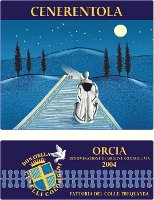
|
|
Orcia Rosso Cenerentola 2004 |
|
| Donatella Cinelli Colombini (Tuscany, Italy) | |
| Grapes: Sangiovese (65%), Foglia Tonda (35%) | |
| Price: € 20.00 | Score: |
| Orcia Rosso Cenerentola shows an intense ruby red color and nuances of garnet red, little transparency. The nose reveals intense, clean, pleasing and refined aromas which start with hints of plum, black cherry and violet followed by aromas of blackberry, vanilla, chocolate, cinnamon, tobacco, mace and menthol. The mouth has good correspondence to the nose, a tannic attack and however balanced by alcohol, good body, intense flavors, pleasing roundness. The finish is persistent with flavors of plum, black cherry and blackberry. Orcia Rosso Cenerentola ages for 12 months in cask and barrique. | |
| Food Match: Roasted meat, Stewed and braised meat, Hard cheese | |
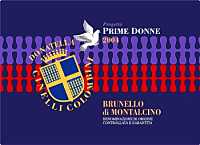
|
|
Brunello di Montalcino Progetto Prime Donne 2004 |
|
| Donatella Cinelli Colombini (Tuscany, Italy) | |
| Grapes: Sangiovese | |
| Price: € 30.00 | Score: |
| Brunello di Montalcino Progetto Prime Donne shows an intense ruby red color and nuances of garnet red, little transparency. The nose denotes intense, clean, pleasing, refined and elegant aromas which start with hints of plum, black cherry and violet followed by aromas of blueberry, blackberry, vanilla, chocolate, cinnamon, tobacco, licorice, mace and menthol. The mouth has good correspondence to the nose, a tannic attack and however balanced by alcohol, full body, intense flavors, pleasing roundness. The finish is persistent with flavors of black cherry, plum and blackberry. Brunello di Montalcino Progetto Prime Donne ages in cask. | |
| Food Match: Game, Roasted meat, Stewed and braised meat, Hard cheese | |
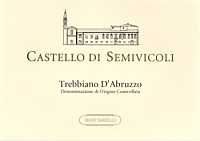
|
|
Trebbiano d'Abruzzo Castello di Semivicoli 2006 |
|
| Masciarelli (Abruzzo, Italy) | |
| Grapes: Trebbiano d'Abruzzo | |
| Price: € 17.50 | Score: |
| Trebbiano d'Abruzzo Castello di Semivicoli shows a brilliant straw yellow color and nuances of greenish yellow, very transparent. The nose reveals intense, clean, pleasing and refined aromas which start with hints of apple, peach and almond followed by aromas of pineapple, citrus fruits, broom, hawthorn, pear and plum. The mouth has good correspondence to the nose, a crisp attack and however balanced by alcohol, good body, intense flavors, pleasing roundness. The finish is persistent with flavors of apple, peach and almond. Trebbiano d'Abruzzo Castello di Semivicoli ages in steel tanks. | |
| Food Match: Stuffed pasta, Roasted fish, Roasted white meat, Stewed fish | |
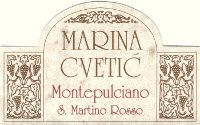
|
|
Montepulciano d'Abruzzo S. Martino Rosso Marina Cvetic 2005 |
|
| Masciarelli (Abruzzo, Italy) | |
| Grapes: Montepulciano | |
| Price: € 17.00 | Score: |
| Montepulciano d'Abruzzo S. Martino Rosso Marina Cvetic shows a deep ruby red color and nuances of ruby red, little transparency. The nose reveals intense, clean, pleasing, refined and elegant aromas which start with hints of black cherry, plum and blackberry followed by aromas of violet, blueberry, vanilla, tobacco, cocoa, licorice, pink pepper, mace and menthol. The mouth has excellent correspondence to the nose, a tannic attack and however balanced by alcohol, full body, intense flavors, pleasing roundness. The finish is very persistent with long flavors of plum, black cherry and blackberry. A well made wine. Montepulciano d'Abruzzo S. Martino Rosso Marina Cvetic ages for 2 years in barrique. | |
| Food Match: Game, Roasted meat, Braised and stewed meat, Hard cheese | |
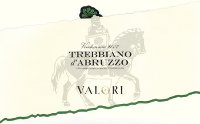
|
|
Trebbiano d'Abruzzo 2008 |
|
| Valori (Abruzzo, Italy) | |
| Grapes: Trebbiano d'Abruzzo | |
| Price: € 5.80 | Score: |
| This Trebbiano d'Abruzzo shows a brilliant greenish yellow color and nuances of greenish yellow, very transparent. The nose denotes intense, clean and pleasing aromas that start with hints of apple, plum and almond followed by aromas of hawthorn, broom and pineapple. The mouth has good correspondence to the nose, a crisp attack and however balanced by alcohol, good body, intense flavors. The finish is persistent with flavors of apple, plum and almond. Trebbiano d'Abruzzo ages in steel tanks. | |
| Food Match: Vegetable and egg appetizers, Risotto with vegetables, Boiled crustaceans | |
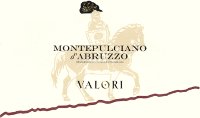
|
|
Montepulciano d'Abruzzo 2006 |
|
| Valori (Abruzzo, Italy) | |
| Grapes: Montepulciano | |
| Price: € 6.50 | Score: |
| This Montepulciano d'Abruzzo shows an intense ruby red color and nuances of purple red, little transparency. The nose denotes intense, clean and pleasing aromas which start with hints of black cherry, plum and violet followed by aromas of blueberry, blackberry and raspberry. The mouth has good correspondence to the nose, a slightly tannic attack and however balanced by alcohol, good body, intense flavors. The finish is persistent with flavors of black cherry, plum and blackberry. This Montepulciano d'Abruzzo ages for 12 months in barrique. | |
| Food Match: Broiled meat and barbecue, Sauteed meat, Cheese | |
|
||||||||
|
DiWineTaste Polls
|
| |||||||
Privacy Policy | |||||||


| Copyright © 2002-2024 Antonello Biancalana, DiWineTaste - All rights reserved |
| All rights reserved under international copyright conventions. No part of this publication and of this WEB site may be
reproduced or utilized in any form or by any means, electronic or mechanical, without permission in writing from DiWineTaste. |